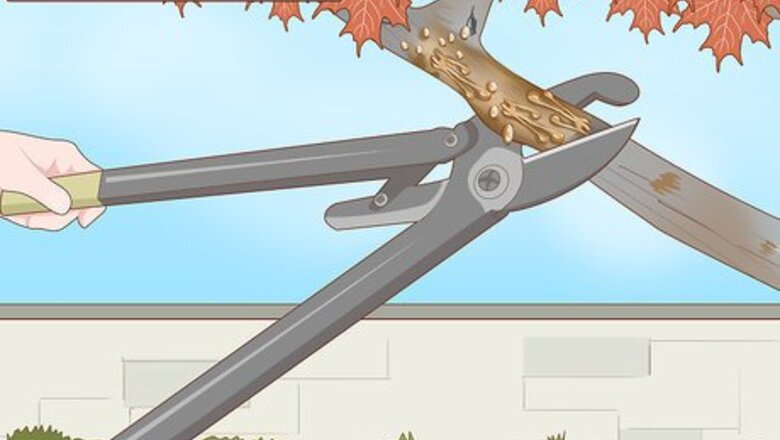
views
Deciding When to Prune
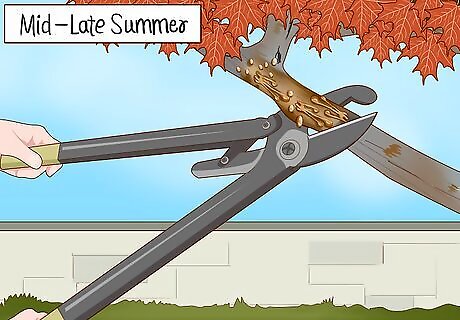
Prune maples in mid- to late- summer. Though most trees should be pruned while in their dormant state, maple trees are the exception. They leak sap when pruned, especially if you do it early in spring. Prune later in the summer to lessen the flow of sap. Sap is like a tree's blood, providing it with nutrients and healing wounds. If it loses too much, it can cause the tree to die off. Plus, this time frame gives the tree a chance to heal before winter.
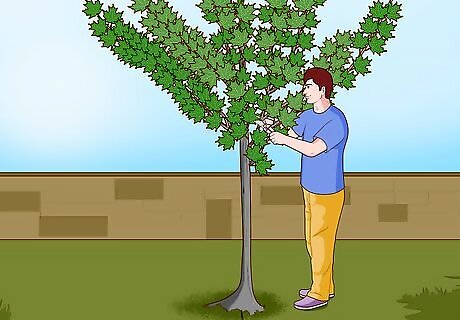
Work on younger trees every other year beginning in year 3. Start trimming younger trees in their third summer. You can apply structural pruning every other year up until the tree is about 10. Then, you'll need to reduce pruning to just dead and weak branches for the most part. It's important to wait until the second or third year of life so that the tree has a chance to get established before you start cutting away branches. If you cut off too much from a young tree, it won't have the leaves it needs to feed itself.
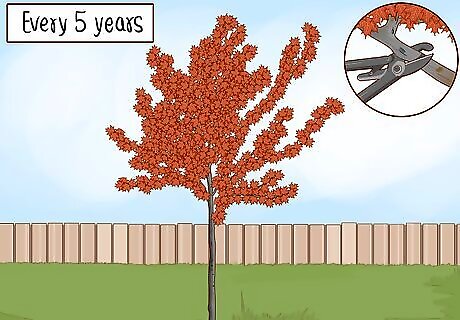
Trim the tree every 5 years after year 10. Once your tree matures, it won't need nearly as much pruning. When pruning older trees, don't try to change the shape. Instead, focus on any thinning that needs to be done, as well as removing the dead branches.
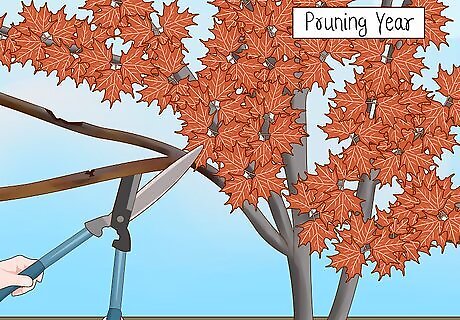
Prune young or old trees any year you see dead branches. While you want to space out your pruning most years, if you see dead branches, make sure to trim the branches that year. You still want to trim at the same time of year, in the summer, but you don't have to wait until it's a "pruning year."
Choosing Limbs to Trim
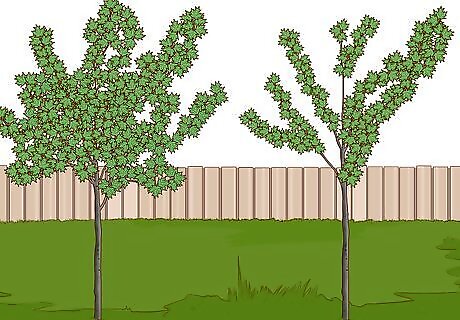
Take out dead and weak branches first. Pick these branches out by looking at the leaves. If you see branches that don't have leaves, those are the ones you want to remove. Also, look for branches that don't have much leafing, as they are likely on their way out. Be sure not take out more than 1/4 of the leaves, as the tree needs those to feed itself. Dead and weak branches are a drain on resources and vulnerable to insect infestation so they need to be removed.
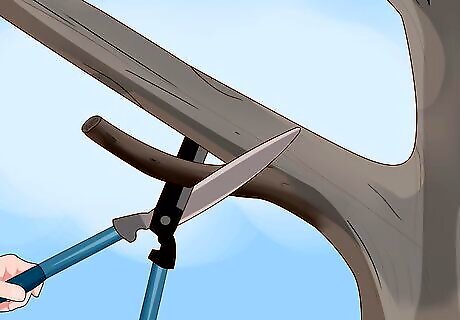
Take off branches that are growing too close together. You don't want branches competing for space. If branches touch or rub, you should trim off the weaker looking branch. Similarly, if a branch is growing towards the trunk or the ground, you should trim that off, too. Also, look for branches that have a narrow crotch angle, meaning they make a "V," and remove those. You should leave branches that have more of a "U" shape where they meet the tree. They will grow at a better angle and are less likely to touch other branches.
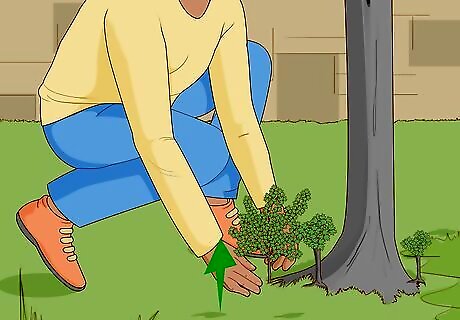
Saw off sucker growth and water sprouts. Sucker growth is when a smaller tree sprouts from the roots near the base of your existing tree. It can limit the main tree's growth, so it needs to be removed. Water sprouts come out of the side of the tree, and they need to be removed for the same reason. You can identify them by the fact that they are young sprouts, not large limbs.

Cut the branches around the leader at the top. The leader is the tallest branch at the top coming straight off the trunk, and the branches around it are the ones that are within 1 to 2 feet (0.30 to 0.61 m). Leave the leader as it is and prune the branches around it by cutting 1/3 of each branch off. You pick one "leader" to be the main branch so that your tree can grow straight and doesn't waste resources on multiple large branches. You cut off branches around it just to give it space to grow. This is typically structural trimming done on younger trees.

Remove the lower branches over several years to create a tall crown. As the tree grows, you can start taking out some of the lower branches. Starting in the third year, trim back the lowest branches. As it grows to maturity, take out enough of the lower branches that you can walk under it. This lifts the crown by making space below. This is structural trimming you should do on younger trees. Only remove enough lower branches so that people can walk under it safely.
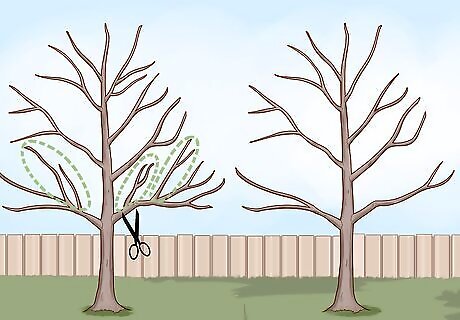
Check the tree for balance. Look at the tree to see where it looks thinner and thicker. Ideally, the branches will be evenly spaced across the tree but without looking too thin. Cut any branches that seem too close together to give the tree room to grow. You can do this on older or younger trees, but younger trees will need it more.
Cutting Limbs Safely

Make a small cut on the bottom of the limb 2 to 3 inches (5.1 to 7.6 cm) from the branch collar. The branch collar is the swollen part of the branch near the trunk. Try not to cut into the branch collar at all. Saw about 1/3 to 1/2 through the branch. You're not trying to saw it off with this cut. Use lopping shears or hand pruning shears to make the cut. You don't want to cut off the branch collar because that leaves a larger, uneven wound. The collar will heal much better than the trunk underneath.

Move 2 to 3 inches (5.1 to 7.6 cm) along the branch to saw through the branch from the top. Saw into the branch going down about 1/3 to 1/2 through it. Your goal is for it to snap off, but making 2 cuts means it won't tear off any bark, which is good, as you want the tree and bark intact. Removing the bark from the branch isn't a big deal, but you want to leave the bark on the tree, as it protects it. Don't try to snap it off. Just saw until the weight of the branch snaps it off.
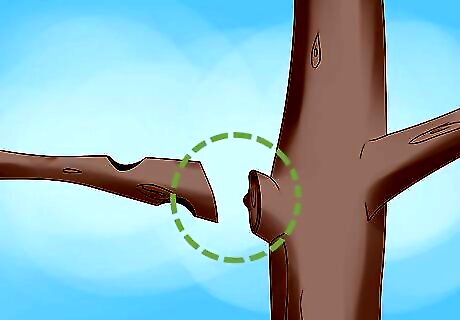
Create a third cut underneath to remove the stub. The stub is what's leftover after you snap off the rest of the branch. Check for the branch collar again, where the branch swells near the trunk. Saw the stub off up near the collar, cutting from underneath and moving up through the limb. Avoid cutting the branch collar. This cut should be perpendicular to the way the branch was growing. It's important to remove the stub because it won't heal like a cut up against the collar. The stub can rot, causing the tree to deteriorate.
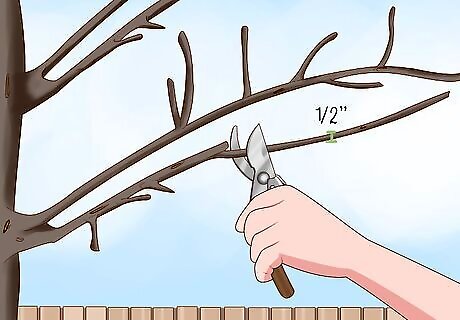
Cut small twigs and branches off with lopping shears. If you have small water sprouts, you can simply cut through them with the shears. Only use shears on branches less than ⁄2 inch (1.3 cm) in diameter.
















Comments
0 comment